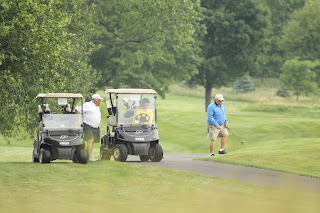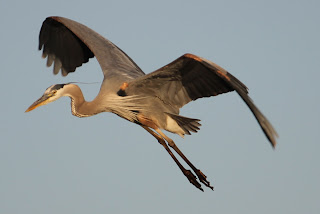It is still dark when Sugata, MB, and I step out the front door
for our walk, but the trees around us are alive with the songs of birds. MB
pulls me forward, occasionally lunging to the side to take in new scents as we
navigate the neighborhood. We cross the
street and walk past part of a golf course, sprinklers spewing water on one
section of the course, groomers mowing another section. The cold morning wind
surprises me; last I was in Lafayette we were daily plagued by stifling heat. Soon
we are crossing Tippecanoe Co. Bridge #1103 toward the Celery Bog. From the bridge we have a great view down
onto the marsh. Red-wing Blackbirds fly past us and perch on cattails along the bank; their red stripes puff out like shoulder-pads as they land. Killdeer strut along the shore, almost invisible against the mud. Some skim over the bridge, piercing the air with their plaintive cries.
While I’m caught up in looking at
a female mallard with her brood dabble in the thick marsh, I notice that I’m
surrounded by quiet music. The intervals are the same as a horn
playing Reveille but the music is much softer, much more subtle and the notes
are in random order. It takes me a moment to figure out the source of the music. The tines of the bridge are catching the
wind and singing; the harder the wind blows, the higher the pitch.
We cross the bridge and descend to the path along the edge
of the marsh. Birds of all kinds teem around the water's edge: Tree Swallows,
Goldfinches, Cardinals, Canada Geese. We spot a cormorant and an eagle, but
most fascinating are the Great Blue Herons who float so gracefully above the
water, long legs tucked behind.
This will not be our last trip to Celery Bog. It has
enchanted us; going there will become a daily morning ritual.
In the evening while talking with Y, she mentions how
Wal-Mart is starting to become the new word for store, “Just like tissue turned
into Kleenex,” she says. Then she mentions the Wal-Mart at Celery Bog. “Wal-Mart? At this
Celery Bog, down here?” I ask. It’s a stupid question. What other Celery Bog
would there be? I’d seen a building on the other side of the marsh, but hadn’t
known it was part of the evil empire.
It
figures; Wal-Mart tends to moves into large swathes of “unsettled land” and “develops”
them. In the late 1990s Wal-Mart bought a piece of land right next to the
Celery Bog which had just been purchased by the city and opened as
a nature area 1995. Wal-Mart’s move was controversial as many opposed the
intrusion of a big corporation right next to the city-owned nature preserve. Wal-Mart
built a small store originally. They lay low for a few years garnering business
as usual with lower than low prices until 2001 when they announced plans to
expand into a Superstore, an undertaking they claimed required filling in an
acre and a half of wetland. They went to the Army Corps of Engineers to
convince them this was the only feasible solution. The Corps gave permission,
with the caveat that Wal-Mart build four and a half new acres of wetland.
Indeed there have been a number of controversial projects
surrounding the bog. In addition to the supersizing of Wal-Mart, there have been serious issues with the road going through the wetlands. I question why the road was built there in the first place. Portions of the road kept sinking into the marsh, leaving bone-jarring washboard, and eventually rendering it entirely impassable. Y mentioned the road has been closed at least thrice for extended periods.(Incidentally, the road problems shut down the traffic that went near Smitty’s, one of the only purely “local” grocery stores, which not long thereafter went out of business).The latest attempt to remedy the road/marsh problem is the bridge, (yes, the singing bridge). We have yet to see how this newest solution stands up to the test.
Then there is the adjacent golf course that decided to remove
dead trees bordering the golf course and the bog to beautify the course (for some ceremony I've been told) and
in so doing, removed the nesting sites of many birds and upset the water table.
Everyone’s basements in Y’s neighborhood flooded soon after.
And this is still not the beginning of humans interfering with the
habitat. According to one interpretive sign we read along the path: “The soil
and topography where prairie potholes are found is ideal for agriculture. As a
result, most pothole wetlands in north-central Indiana have been drained and
filled. Efforts to restore this critical habitat are in progress at Celery Bog,
the Kankakee Marsh, and other locations.” Celery Bog has been a wetland since
the last ice age, but it was once drained in the late 1800s by enterprising farmers
who figured the rich peat would make excellent farmland. Many crops indeed grew
well there, among them celery. In the 1960s the water levels rose and the
farmers were unable to maintain the land for farming; it returned to marsh.
And the herons came.
I watch spellbound as a Great Blue
Heron floats over the shallow water for landing. He lets his long legs dangle; his feet skim the surface before he pulls
them forward to step from sky to water.
All pictures taken by Sugata and Sonya near Celery Bog.
All pictures taken by Sugata and Sonya near Celery Bog.
A great, informative article about the history of Celery
Bog:
History of Farming at Celery Bog:
Removal of trees from golf course:
Development of Celery Bog:















